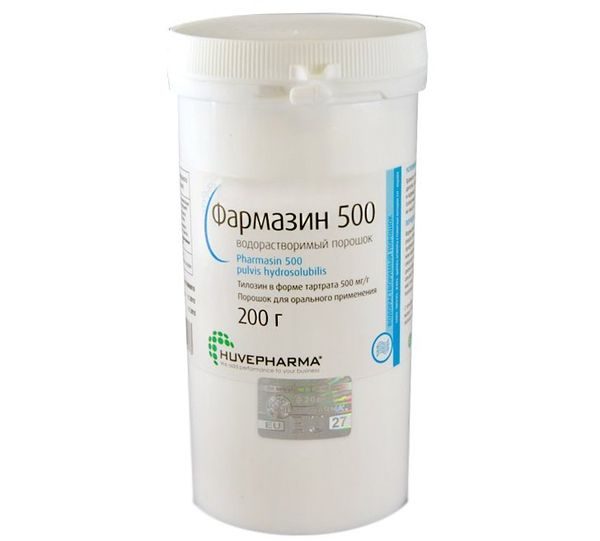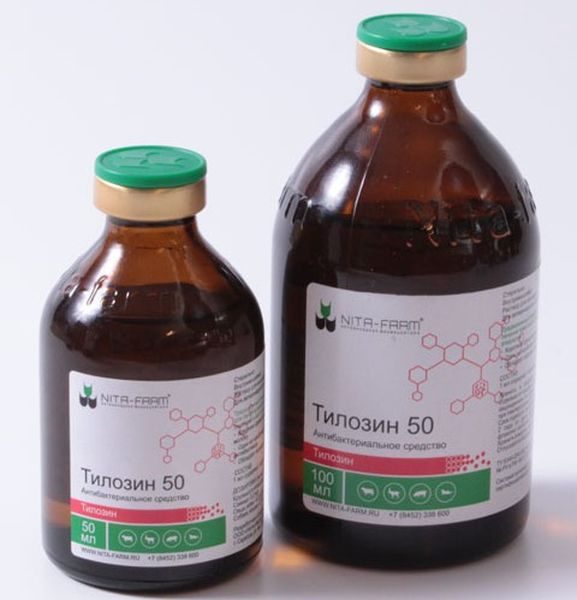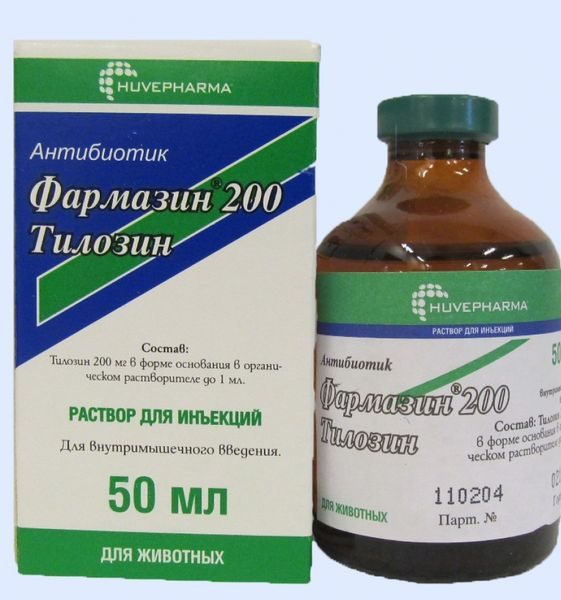Diseases of animals for each breeder is stressful, I want to get rid of the problem as soon as possible and with minimal discomfort for myself and my wards.
But what if a chick appeared in respiratory microplasmosis, representatives of a larger one, such as turkeys, found infectious sinusitis, digestive problems in pigs, and in calves in general, bronchi and lungs became inflamed?
There can not do without antibiotics. Assistant for all the above problems may be farmazin. Veterinary drug produced in Bulgaria.
Only a qualified specialist can prescribe treatment with any particular drug. When prescribing and choosing an antibiotic for animals need a consultation of a veterinarian!
Table of contents
What diseases are used for?
- Respiratory microplasmosis, various respiratory diseases - in birds
- Infectious sinusitis - turkeys
- Arthritis, atrophic rhinitis, gastroenterocolitis, dysentery, enzootic pneumonia - in piglets
- Infectious agalictia - in goats and sheep
- Bronchopneumonia - in cows, goats, sheep, piglets and domestic dogs, kittens
- Mastitis - in cattle.
What are the dosages
Antibiotic is available in two forms:

Powdered farmazin 500 with a dosage of tylosin 500 mg. For ease of use Packed in containers of 25 and 200 grams in plastic jars with lids or paper-plastic bags. Excipient: lactose monohydrate.
Also attached to it is an instruction, a mark (labeling) about the manufacturer, batch, expiration dates and conditions under which it is necessary to store plus other necessary information.
The second packaging option is a solution for intramuscular injections of Farmazin 50, respectively, with a dosage of the active substance tylosin 50 mg. Liquid Farmazin packaged in bottles of 25 ml. and 50 ml. sealed with rubber corks and clamped with aluminum caps.
The excipient here is 1,2-propylene glycol and water. Each bottle is packed in a personal box, which is supplemented with instructions for using the drug.
Marking in Russian, manufacturer's designation (address of production, company logo, company name), drug name, net volume in a vial or pack, temperature conditions, permissible humidity and shelf life, batch number, clarification of what it is for “Intramuscular "Or orally and sterility is all list of mandatory designations that must be present on each copy antibiotic for animals.
How to apply for chickens
Farmazin 500 is available in powder form.Before using it, it is necessary to dilute it a little with water, mixing water in powder, and not vice versa, then add more water and dilute to the desired concentration.
If it is intended to use medicine for birds, then it is necessary to dilute it to the ratio of 1 gram per 1 liter of water. Broilers need to drink the medication for three days, and poults for five days (the recommended growing periods are listed below).
Drinking bowl with the drug should be in animals during the entire time of taking the antibiotic. Dilute the drug must be daily (change to fresh).
In order to ensure that the animals receive an adequate antibiotic, it is necessary to remove all containers with liquid except the one where the drug is diluted, then the concentration of the substance entering the body will be sufficient for treatment and prevention, and last but not least - controlled!
In the treatment and prevention of chickens, goslings, poults and other chicks follow the recommended schedule and dosage, namely:

If we are talking about chicks who are supposed to be used for breeding work, then the suitable rearing period for the prevention and treatment of farmazine is:
- from 1 to 5 day
- from 28 to 29 days,
- from day 56 to day 57
- from 140 to 141 days.
Industrial bird of egg breeds:
- Day 1 to Day 3
- 28 days.
Repair young animals are recommended to be treated according to the scheme:
- from 1 to 3 days
- from 28 to 29 days.
- turkeys and broiler breeds are recommended to be treated according to the scheme applied to the repair young.
Instructions for use farmazina for adult birds
The preparation is not recommended to birds-layers, since Tylosin is accumulated and excreted together with eggs; it is forbidden to use eggs obtained during the period of use of the drug for culinary purposes.
Farmazin 50 is mainly used for large livestock, piglets, small livestock, dogs, cats. For chickens, turkeys and other birds do not use Farmazin 50.
Side effects and contraindications
Farmazin not recommended to give:
- kuram-layers,
- mature animals with developed cicatricial digestion,
- animals with strong sensitivity to tylosin.
Pharmacological properties
Farmazin is a veterinary antibiotic from a macrolide group. Water soluble fine powder. The shades from white to cream, not the usual peculiar smell and bitter taste, but the solution for intramuscular injections are shades from transparent to light yellow. The active ingredient is tylosin.

Tylosin is detrimental to:
- Streptococcus
- Pasteurella
- Staphylococcus
- Corinebacteria
- Vibrioes
- Microplasma
- Clostridia
- Chlamydia
- Erisipelotraxes
- Treponema
- Spirochetes
Exposure occurs at the ribosome level, inhibiting protein synthesis at the molecular level.
Ribosome is the most important non-membrane organoid of a living cell, which is used for protein biosynthesis of amino acids in a given matrix based on genetic information provided by messenger RNA (mRNA).
Farmazin 500 dissolves in water, entering the body is carried with blood throughout the body accumulating in greater concentration in:
- the liver more so
- the kidneys less,
- lungs less,
- dairy glands - in dairy animals,
- eggs - in rushing animals.
A single dose of the drug will keep the concentration for the realization of therapeutical properties for:
- Farmazin 50 (for intramuscular administration) is preserved more than 20 hours
- farmazin 500 (for oral administration) is maintained more than 15-18 hours
Farmazin also differs in the property of selectively accumulating in the primary source of inflammation, which makes it possible to purposefully influence the focus. For the most effective treatment, it is necessary to check the sensitivity of the causative agent of the disease to the active substance, tylosin.
Hazard level - moderate (class 3 according to GOST 12.1.007)
Conclusion
Proceeding from the fact that pharmazin entering the body accumulates in the eggs, use it for culinary purposes, taken down during the period of taking the antibiotic and for the next five days after the last dose of the antibiotic, eggs are forbidden There is a risk of sensitization.

Sensitization (French sensibilisation, from Latin sensibilis - sensitive) is a biological term, the body acquiring a specific hypersensitivity to foreign substances - allergens.
The same applies to other animals intended for slaughter.Slaughter of piglets and poultry is allowed after 5 days from the last administration of Farmazin 500 (soluble powder), calves can be slaughtered after 14 days.
If an animal, for some reason, has been slaughtered before the recommended period, then its meat can be used only for feeding carnivores or to put it into the production of meat and bone meal.
It is also important to be careful when using the drug:
- Not to drink
- Do not smoke
- Do not eat
- Do not use bags and vials of the drug for household purposes.
Upon contact with the skin, it is necessary to wash it off with a soap solution.
To avoid the manifestation of a decrease in the antibacterial effect of tylosin It is not recommended to combine with:
- Cephalosporins
- Clindamycin
- Levomycetin
- Penicillins (mainly with ampicillin and oxacillin)
- Lincomycin.
- Tiamulin
